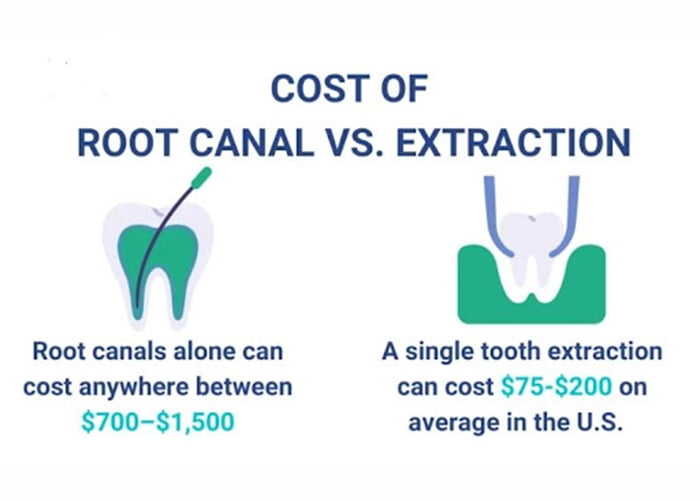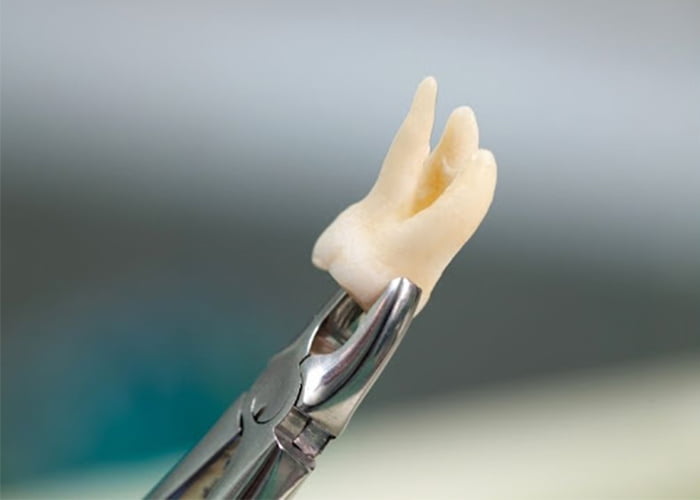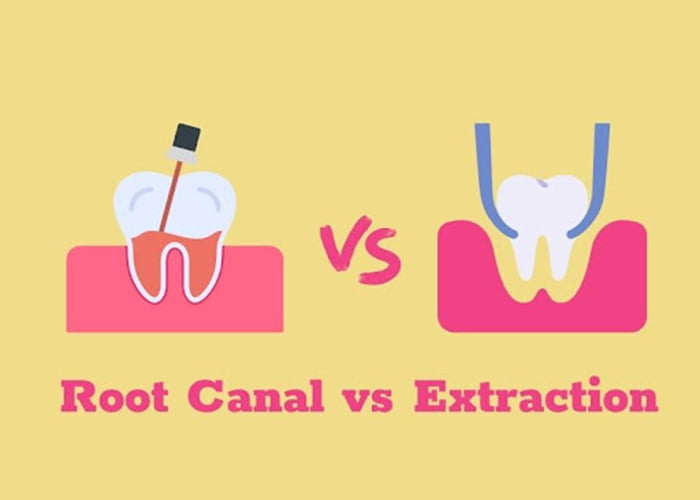A root canal vs extraction is two common procedures to relieve pain, get rid of an infection, and repair damage if you have a severe tooth infection or tooth damage. Root canal therapy is the best option for saving a tooth, but extraction is often recommended when the tooth is too badly damaged or has a crack. Some people choose extraction over a root canal because it is less painful and more affordable. To assist you in choosing the best course of action for your dental health, this piece examines the root canal vs. extraction pros and cons.
When faced with a damaged or infected tooth, deciding between a root canal and extraction can be a difficult decision. This article will help you make an informed decision!
Cost of Root Canal
The cost of a root canal treatment varies depending on the location of the tooth, the severity of the damage, and the dentist’s experience. The average cost is $500 to $1,500 per tooth in the US but may be higher if additional procedures are needed. In some cases, dental insurance may cover part or all of the cost of the treatment.
Cost of Dental Extractions
The cost of dental extractions can vary depending on the complexity of the extraction, the location of the tooth, and the geographic region. In the US, a simple extraction can range from $75 to $300 per tooth, while a surgical extraction can cost from $225 to $600 per tooth.
Root canal vs extraction price can vary depending on several factors. In general, the cost of a root canal treatment is typically higher than the cost of a simple extraction.

What are the risks of Root Canals and Dental Extractions
Like any dental procedure, there are risks associated with both root canals vs dental extractions. Here are some of the potential risks:
Root Canal Risks:
- Infection: If bacteria is not fully removed during the procedure, it can lead to infection in the tooth or surrounding tissues.
- Nerve damage: In rare cases, nerve tissue in the tooth can be damaged, leading to pain, numbness, or tingling.
- Fracture: The tooth may be weakened by the root canal procedure, which can increase the risk of fracture or breakage in the future.
- Failure: In some cases, the root canal may fail to fully treat the problem, and the tooth may need to be extracted.
See more: How Long Does a Root Canal Take?
Dental Extraction Risks:
- Pain and swelling: Pain and swelling can occur after dental extraction, especially if a tooth is impacted or multiple teeth are extracted.
- Bleeding: Some bleeding is normal after dental extraction, but excessive bleeding can occur in rare cases.
- Nerve damage: Nerves damaged during extraction can lead to pain, numbness, or tingling.
- Infection: If bacteria enters the extraction site, it can lead to infection in the tooth socket or surrounding tissues.
- Dry socket: Blood clot formation after extraction can cause pain and delay healing.
Tooth Extraction: Procedure and Aftercare
Tooth extraction is a dental procedure in which a tooth is removed from its socket in the jaw bone. Here is a general overview of the procedure and aftercare:
Procedure:
- Before the extraction, the dentist will numb the area around the tooth with a local anesthetic to minimize pain and discomfort during the procedure. The dentist will use a special instrument called an elevator to loosen the tooth from the socket.
- Once the tooth is loosened, the dentist will use forceps to carefully remove the tooth from the socket. If needed, the dentist may stitch the extraction site to promote healing.

Your dentist will provide specific instructions for aftercare based on your case. You should bite down on gauze to stop bleeding, apply an ice pack to the outside of the cheek near the extraction site, take any prescribed pain medication, avoid using a straw or spitting forcefully, and avoid smoking, drinking alcohol, or vigorous physical activity for at least 24 hours after the procedure.
You must stick to soft foods and avoid chewing on the side of the mouth where the tooth was extracted, and brush and floss your teeth as normal for the first few days.
Root Canals: Procedure and Aftercare
Root canal treatment is a dental procedure that is performed to treat a tooth that is infected or inflamed in the pulp (innermost layer of the tooth). Here is a general overview of the root canal procedure and aftercare:
Procedure:
- The dentist will numb the area around the tooth with a local anesthetic to minimize pain and discomfort during the procedure.
- A small hole is made in the top of the tooth to access the pulp chamber and canals.
- The dentist will use small instruments to remove the infected or inflamed pulp from the tooth.
- The canals are then cleaned and shaped to prepare them for filling.
- The canals are filled with a special material called gutta-percha to seal them and prevent further infection.
- A temporary filling is placed in the tooth to protect it until a permanent filling or crown can be placed.

It is common to experience some pain and sensitivity after a root canal procedure. Your dentist may prescribe pain medication or recommend over-the-counter pain relievers to manage discomfort. Avoid eating or drinking until the numbness wears off to avoid biting your tongue or cheek.
Avoid eating or drinking until the numbness wears off, chew on the side of the mouth where the root canal was performed, and practice good oral hygiene. Follow instructions for follow-up appointments and the placement of the permanent filling or crown. Contact your dentist if you experience severe pain, swelling, or any other signs of infection.
The Necessity of Root Canals & Extractions
Root canals vs dental extractions are both dental procedures that are typically performed to treat and resolve dental issues. Root canals and extractions are necessary for a variety of reasons. In the case of root canals, decay can penetrate the outer layers of the tooth and reach the pulp, leading to inflammation and infection.
In other cases, tooth decay may be too advanced to be treated with a filling or root canal, and extraction may be necessary to prevent further damage to surrounding teeth and tissues. Crowding of teeth is another reason for extraction, as some teeth may need to be extracted to make room for proper alignment. Alternative treatments may be available, but a root canal or extraction may be the best option to resolve the issue and prevent further damage.
Read more: What to Eat After a Root Canal?
Why Root Canals Are Chosen Over Extractions
When a dental issue requires either a root canal or extraction, it is important to consider the advantages and disadvantages of each procedure. A root canal is often preferred over an extraction because it allows a patient to keep their natural tooth and offers better functionality.
Are root canals worth it? Yes, It is less invasive than an extraction, and it usually involves less pain and a shorter recovery time. Cost-effectiveness is also important when choosing between a root canal and an extraction, as a root canal is less expensive than an extraction followed by a dental implant or bridge to replace the missing tooth.
Let Us Help You Keep Your Teeth Healthy at Marysville’s Dentist For Life
Let us help you keep your teeth healthy at Marysville’s Dentist For Life. Our experienced dental team is committed to providing high-quality dental care to patients of all ages. Whether you need routine cleaning or more extensive dental work, we are here to help you maintain a healthy smile.
We strive to create a comfortable and stress-free environment for our patients and build lasting relationships with them. If you’re looking for a reliable dentist in Marysville Ohio, look no further than Dentist For Life. Contact us today to schedule an appointment, and let us help you keep your teeth healthy for life.



